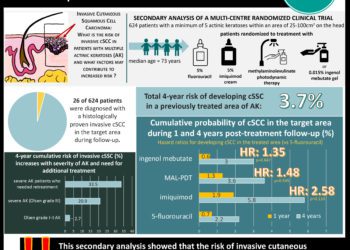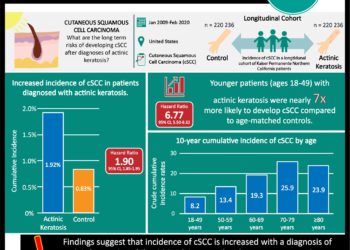Photodynamic therapy has high efficacy in treating face and scalp actinic keratosis
1. Photodynamic therapy (PDT) was more effective in achieving complete clearance of thin actinic keratoses (AKs) on the face and scalp than cryotherapy.
2. PDT produced more favorable responses than other therapies in regards to cosmetic results and patient satisfaction.
Evidence Rating Level: 2 (Good)
Study Rundown: AKs are characterized by crusty or scaly patches of skin that may occasionally progress to squamous cell carcinoma. As such, treatment is recommended for both medical and cosmetic reasons. Several therapies are commonly used in the treatment of AKs (PDT, cryosurgery, ect). PDT entails injection of a light sensitizer and usage of a laser to resurface the lesion and surrounding skin. PDT is commonly reported to be the most efficacious, but little data are available to support this claim. These authors sought to determine the most effective treatment for AKs on the face and scalp. Findings were based on the clearance of lesions following therapy, cosmetic results, and patient satisfaction from standardized surveys. PDT was found to have the highest chance of complete lesion clearance of the methods studied. While statistical analysis attempted to minimized bias, a weakness of this study was the possibility for confounders.
Click to read the study in JAMA Dermatology
Relevant reading: A network meta-analysis of the relative efficacy of treatments for actinic keratosis on the face or scalp in Europe
In-Depth [systematic review and meta-analysis]: Four databases were scanned using the keywords: solar keratosis, actinic keratosis (MeSH), photodynamic therapy, and photochemotherapy (MeSH). 875 reports were identified, and after applying selection criteria, 13 studies remained for review of which 4 were eligible for meta-analysis. The 4 studies eligible for meta-analysis produced a total of 641 participants with 2174 AKs treated with cryotherapy and 2170 AKs treated with PDT. Meta-analysis demonstrated a significantly increased efficacy of PDT in the treatment of thin AKs on the face and scalp when compared to cryotherapy (OR, 1.86), but no difference was found in the treatment of moderate to thick AKs. The pooled relative risk for complete lesion response was 1.14 (95% CI, 1.11-1.18) for PDT, which equated to a 14% increased likelihood of achieving lesion clearance using PDT. In terms of cosmetic outcomes and patient satisfaction, PDT was largely favored over other therapies and was shown to more subjectively improve lentigines, skin roughness, fine lines, and sallow complexion. All included trials had Jadad scores of 1-2, attributable to the lack of double-blinded design and description of randomization methods.
More from this author: Models predict the relationship between nonmelanoma skin cancer and ambient UV radiation, Mutation linked with decrease in cutaneous diffuse large B-cell lymphoma , Population-based risk factors and geographical trends identified for vitiligo
Image: PD
©2012-2014 2minutemedicine.com. All rights reserved. No works may be reproduced without expressed written consent from 2minutemedicine.com. Disclaimer: We present factual information directly from peer reviewed medical journals. No post should be construed as medical advice and is not intended as such by the authors, editors, staff or by 2minutemedicine.com. PLEASE SEE A HEALTHCARE PROVIDER IN YOUR AREA IF YOU SEEK MEDICAL ADVICE OF ANY SORT.







